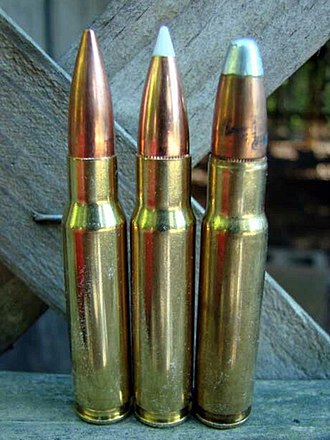| .338 Federal | ||||||||||||||||
|---|---|---|---|---|---|---|---|---|---|---|---|---|---|---|---|---|
 .338 Federal between .308 Winchester (left) and .358 Winchester (right) | ||||||||||||||||
| Type | Rifle | |||||||||||||||
| Place of origin | United States | |||||||||||||||
| Production history | ||||||||||||||||
| Designer | Federal Cartridge / Sako | |||||||||||||||
| Manufacturer | Federal Cartridge | |||||||||||||||
| Produced | 2006 | |||||||||||||||
| Specifications | ||||||||||||||||
| Parent case | .308 Winchester | |||||||||||||||
| Case type | Rimless, bottleneck | |||||||||||||||
| Bullet diameter | .338 in (8.6 mm) | |||||||||||||||
| Neck diameter | .369 in (9.4 mm) | |||||||||||||||
| Shoulder diameter | .454 in (11.5 mm) | |||||||||||||||
| Base diameter | .470 in (11.9 mm) | |||||||||||||||
| Rim diameter | .473 in (12.0 mm) | |||||||||||||||
| Rim thickness | .049 in (1.2 mm) | |||||||||||||||
| Case length | 2.01 in (51 mm) | |||||||||||||||
| Overall length | 2.75 in (70 mm) | |||||||||||||||
| Primer type | Large rifle | |||||||||||||||
| Maximum pressure | 62,000 psi | |||||||||||||||
| Ballistic performance | ||||||||||||||||
| ||||||||||||||||
| Test barrel length: 24" Pac-Nor Source(s): Nosler Load Data, [1] Hodgedon Reloading Data Center [2] | ||||||||||||||||
The .338 Federal is a rifle cartridge based on the .308 Winchester case necked up to .33 caliber. It was created by Federal Cartridge and Sako in 2006 and intended as a big-game cartridge with reasonable recoil for lightweight rifles. [3] .338 Federal can fit SR-25 pattern magazines but requires some modification for reliability [4]